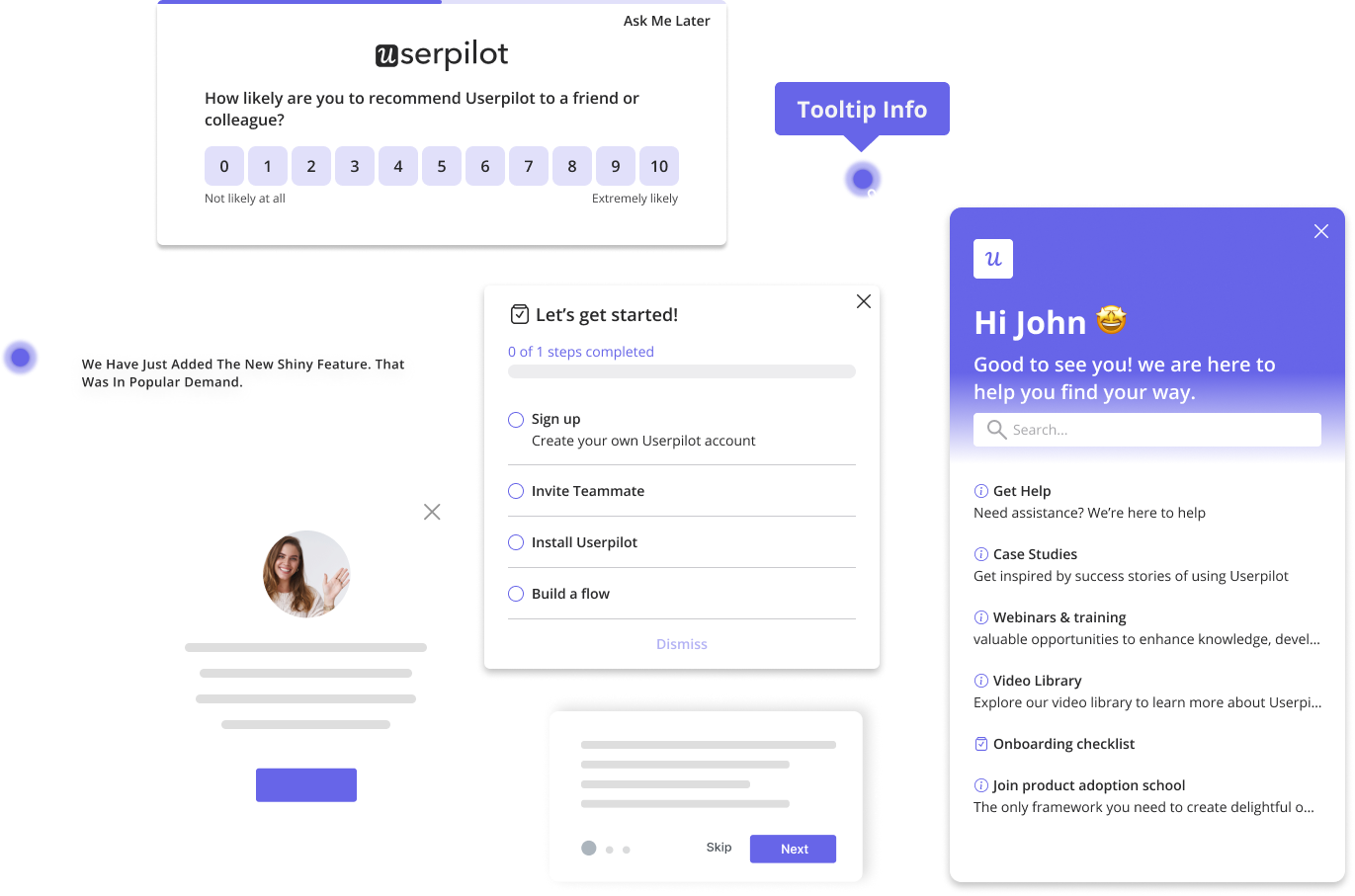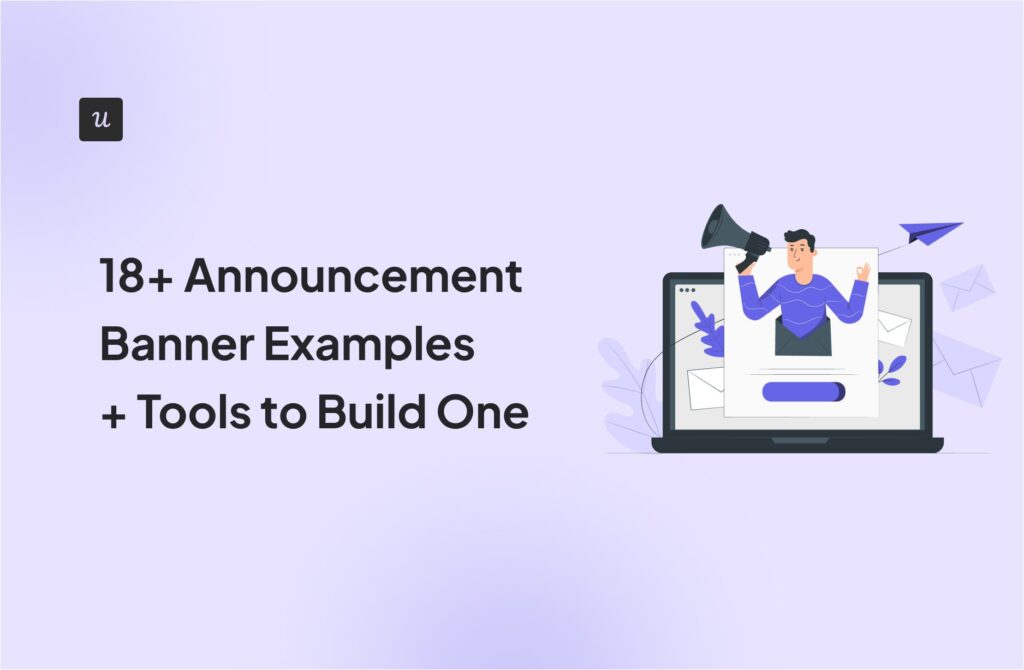![Create a User Persona: Your Blueprint for Product Growth [+ Template] cover](https://blog-static.userpilot.com/blog/wp-content/uploads/2025/07/how-to-create-a-user-persona-your-blueprint-for-product-growth-template_91fa386e7ffe6c2276fb4f3cd8317bf7_2000.png)
How to Create a User Persona: Your Blueprint for Product Growth [+ Template]
As a product manager, I’ve come across all the common obstacles to creating personas. And what I’ve learned is that, besides getting stakeholder buy-in, you need a solid process to collect high-quality data, organize user segments, and create story-driven personas that are easy to follow.
Otherwise, you’ll end up with guesswork-based personas that aren’t actionable enough to drive product decisions nor relatable enough to inspire, and the work of all your company’s teams will stay disconnected from real customer pain points.
In Userpilot, data-based personas are a crucial part of our product management process and dictate our product decisions, marketing messages, and product roadmaps. So in this guide, I’ll lay out the exact four-step process I use to create useful personas, plus share a free template you can use.
How are you currently trying to understand your users?
To create a user persona that’s truly effective, you need to start with your current methods.
What is your biggest challenge with data collection?
Gathering the right information is a common hurdle when you create a user persona.
How do you currently create a user persona?
The process itself can determine the success of your personas.
What’s your primary goal with user personas?
Defining your objective helps focus your efforts.
Ready to create data-driven user personas, automatically?
Stop guessing and start understanding. See how Userpilot can help you create a user persona based on real product usage data and user feedback, so you can drive activation, adoption, and retention.
Try Userpilot Now
See Why 1,000+ Teams Choose Userpilot
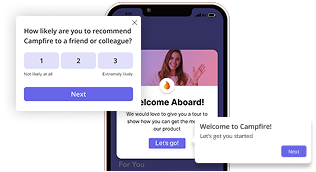
Why do you need user personas?
A user persona is a semi-fictionalized user profile that captures the properties of a given customer segment, including their demographics, role, goals, and pain points. For SaaS, it must be framed in the context of how they use your product and their jobs-to-be-done.
But while the characters created in the process are fictional, their building blocks must be based on high-quality customer data. Such personas can benefit all company departments:
- Product management teams can prioritize their backlog items based on the jobs-to-be-done that matter most. Good personas open the door to following a user-centric product development strategy.
- Product design teams and UX researchers can personalize in-app guides and UI to solve persona-specific problems. This helps them avoid implementing one-size-fits-all in-app flows or overwhelming users with irrelevant features.
- For engineering, user personas can keep development focused on pain points and help devs adopt a user-centric mindset.
- Product marketers can personalize their campaigns based on the pains and desired outcomes of their ideal customer.
- Customer success can design onboarding and guides that align with the use cases of the customer.
What should a user persona profile include? User persona template
When you don’t have the full picture of your user base, it can be tempting to try to fill the gaps with educated assumptions instead of real data.
However, you should always collect real user data instead of relying on gut feelings.
At Userpilot, I follow a simple template that includes all the details necessary for product managers. Here’s what information it includes:
- Demographics: I only capture the persona’s professional occupation relevant to our product’s B2B profile. But you can also add location, age, and gender.
- Jobs-to-be-done (JTBDs): This includes all the tasks that your customer pays you to deal with, such as designing onboarding, proving product ROI, reducing churn, and so on.
- Company details: I record company size, funding stage, and if possible, their core tech stack (e.g., “Series B, 120-person SaaS on AWS”).
- Team collaboration: It explains how the persona works with other teammates. For instance, I note how many teammates they invite, who approve changes, and where hand-offs happen.
- Pain points: I include the problems and friction points the persona often encounters without our solution, e.g., data silos, slow product adoption, or over-reliance on engineers.
- Gains of using the product: A list of specific wins the persona will have with your application.
For example, here’s our user persona example of a Product Manager. Feel free to duplicate it and swap in your data to get started!
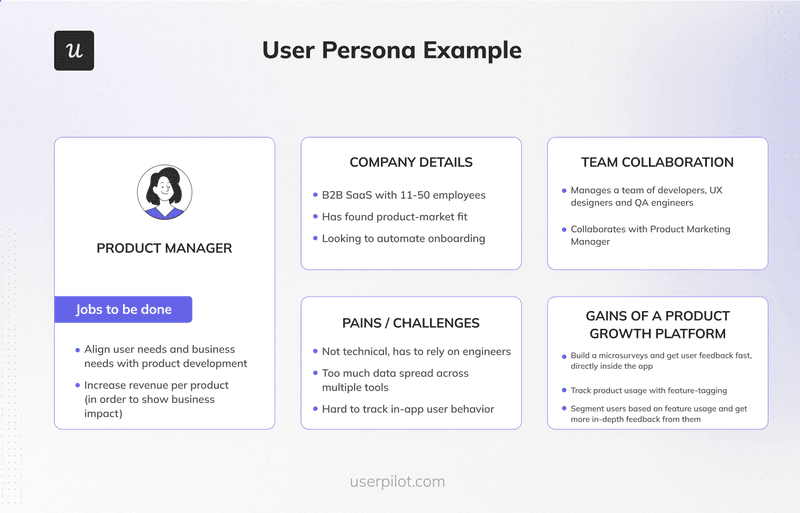
Userpilot’s user persona template.
Create user personas in 4 steps: Practical guide
As I mentioned, creating a meaningful persona must be based on real user research and solid data. It must follow a structured approach to data collection, user segmentation, and creating a narrative.
So here’s the process I follow to build data-driven personas that genuinely guide our work.
1. Collect real user data
To create accurate personas, your first step is to replace assumptions with user research, including both qualitative and quantitative data.
Below, I’ll break down each data collection method.
No users yet? Do market research
Before Userpilot had active users, we built our personas using market research as the backbone. It’s the simplest way to ground your first profiles in reality, even without live customer data.
Market research is essentially the systematic process of learning about your potential customers and the market landscape. Thus, at this early stage, I typically rely on three key methods:
- Surveys: Market research surveys help quantify common challenges, goals, and budgets.
- Interviews: 1-on-1 conversations with 5-10 early adopters can reveal key qualitative insights, such as nuanced frustrations, inefficient processes, or unmet needs.
- Focus groups: Gather 5-8 participants from your target users in a moderated discussion. These sessions can bring shared pain points or trends that one-on-one conversations might miss.
But since market research is a complex and important process, take a look at our guide to primary market research if you’d like to get started.
Gather basic user information during sign-up
Once you already have a product with an active user base, the first user persona research method to implement is adding data-collecting forms during the sign-up flow or onboarding process. It’s quick, users find it natural, and you can instantly get crucial information for your personas, such as:
- Demographic information (e.g., professional role, seniority level).
- Jobs-to-be-done/goals (the primary reason they’re trying your product).
- Company details (team size, company industry, etc.).
For example, at Userpilot, I added a simple welcome survey immediately after signup. The questions are short, targeted, and unintrusive.
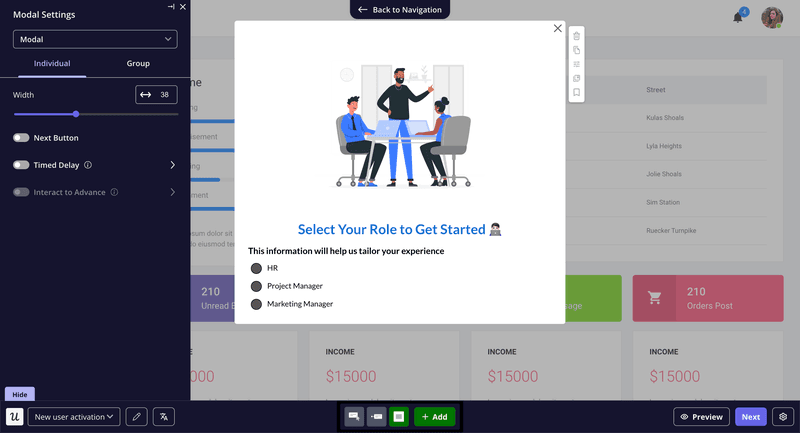
Creating a welcome survey with Userpilot.
Talk to customer-facing teams
An underrated yet powerful way to validate personas is collaborating with customer-facing teams like sales, customer success, and support. Why? These teams interact daily with users and have a goldmine of information about customer needs, pain points, and use cases.
Here’s exactly how I leverage their expertise:
- Schedule interviews with sales reps and CSMs. I usually ask about common customer goals, frequent friction points, feature requests, and product misunderstandings. I recommend re-doing them every couple of months to keep personas up-to-date.
- Review customer support tickets monthly for repeated questions or patterns of confusion.
- Sit with team members to watch recorded customer calls to better grasp user sentiment and adopt their language.
Watch user session replays
What I love about session replays is how they connect qualitative and quantitative data. They give context to behavioral data observed with user funnel analytics and illustrate issues mentioned in surveys or interviews.
At Userpilot, we regularly use session replays to:
- Spot confusing UI elements, such as areas where users hesitate, click repeatedly, or abandon tasks.
- Understand the preferred workflows of different personas.
- Validate assumptions and ensure our personas are accurate.
Plus, Userpilot’s replay feature requires zero extra code or dev resources. I simply pull up a recording, add timestamped comments for teammates, and tag the exact moments where bugs happen.
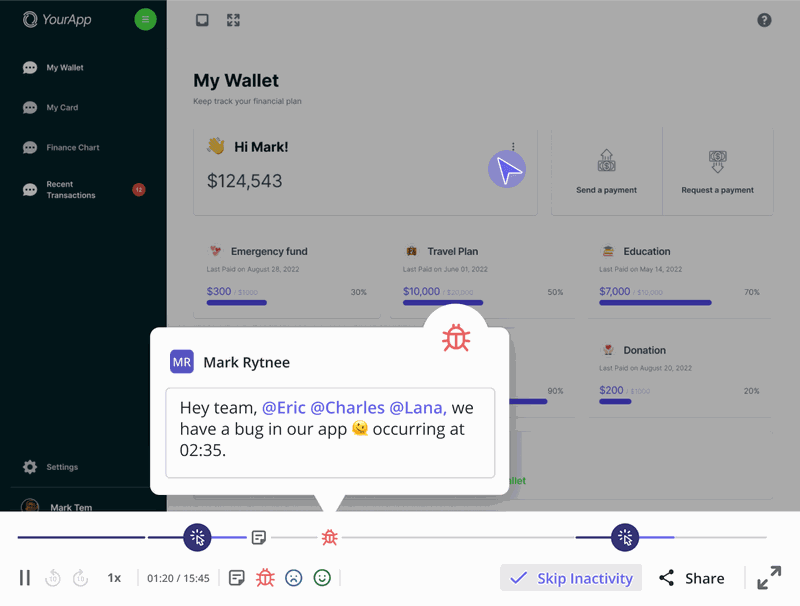
Tagging a bug on a session replay with Userpilot.
Track product usage and user behavior data
Lastly, I always look at product usage analytics. This quantitative data reports help me create hypotheses about favorite features, goals, or common obstacles that I can confirm with other research methods.
Plus, it adds another layer of certainty, highlighting actual user habits, adoption patterns, and the features users find most valuable.
With Userpilot, I track key behavioral metrics like:
- Feature adoption: Which features are most used or ignored by specific segments?
- Common user paths: How do users move through the product? What user paths correlate with success?
- Engagement levels: How active are users? How long does it take to perform key tasks?
- Drop-off points: Where do users tend to abandon a task?
What’s better, since Userpilot has no-code event tagging, this process is painless even for non-technical teams. PMs can quickly label and track specific user actions on customizable analytics dashboards without relying on engineers or data science teams.
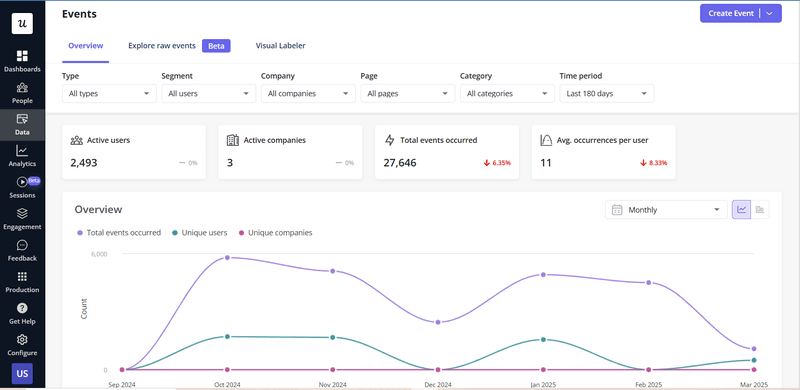
2. Segment your audience
With the data you’ve collected, the next crucial step is to group different user types based on attributes or behavior. Customer segmentation ensures your personas accurately represent distinct user groups, eliminating guesswork from your product strategy.
Once I have a grasp of the data, I take two segmentation types into consideration:
- Customer segmentation: Customer segmentation focuses on information such as the user’s demographics and firmographics as well as their JTBDs, pain points, and goals.
- Behavioral segmentation: Behavioral segmentation involves grouping users based on actual product interactions and their stage in the user journey. For example, you can segment users who dropped off during the onboarding flow or those who hit the usage limit of their plan.
Don’t worry if some parts of your segments overlap. That’s actually a good thing that suggests a strong product focus and a good product-market fit.
3. Create user personas with a template
With clear segments defined and validated, you can start creating engaging personas with a user persona template.
First, you want to identify between 2-5 primary personas based on segment size, revenue impact, or strategic importance. More than five personas will dilute your focus and make it harder to prioritize projects.
After that, it’s time to fill out the template we provided earlier. For this, move your collected data under each heading, including demographics, goals, JTBDs, pain points, gains, company details, and collaboration style. Remember to keep each point brief and actionable.
When finished, you’ll have a set of robust personas you can start including in your projects.
4. Write a short bio
At Userpilot, I’ve found that a persona truly resonates when you craft brief yet relatable narratives that reflect real people.
Here’s why I think storytelling matters in your personas:
- It builds empathy: When the team reads about “the PM juggling feature rollouts in a 100-person SaaS,” her struggles feel genuine. Everyone understands why her pain points matter.
- Helps target goals and challenges: A narrative naturally highlights the emotions and needs behind each goal. Thus, your team can get much more efficient at designing features or creating marketing materials that address those goals.
- It aligns teams: People remember stories far better than raw data. This helps everyone in the company align their work toward the target audience and become user-centric.
“A Product Manager at a rapidly scaling 100-person SaaS. She’s laser-focused on improving onboarding to reduce early churn, but obstacles in at-scale data tracking force her to sometimes make guesses about user behavior. She needs clear, actionable insights that can be collected without coding and will smoothly fit into her already packed day.”
Best practices to create effective user personas
In chats with fellow PMs, I’ve consistently heard frustration around maintaining and using personas effectively. Without repeatable processes, once-prepared user personas tend to get outdated, aren’t actionable, are are ignored by the team.
Here’s how I’ve tackled these challenges at Userpilot, and how you can too:
- Refresh persona data regularly: Users’ needs evolve rapidly, and so should your personas. For this, we schedule check-ins every six months to update personas with fresh insights from user analytics, customer interviews, and product data.
- Limit yourself to 2-5 personas: As I mentioned, too many personas dilute your focus and make it difficult to prioritize projects. For this, I focus on high-impact segments based on revenue potential and retention metrics.
- Stick strictly to data: It’s easy to fill the gaps with educated guesses. However, every persona detail must be tied to user behavior, user feedback, and market research. Don’t make any exceptions and do additional research if needed.
- Get your whole team on board early: Personas get ignored by teams because if don’t see their value. To get around this, I actively involve stakeholders in the persona creation process and regularly demonstrate their impact in meetings, sprint reviews, and retrospectives.
User personas: Your north star for product growth
When you create a user persona based on actual data and real-life stories, you can design user-centric products that will drive higher feature adoption, increased customer retention, and stronger product-market fit.
With a tool like Userpilot, creating and maintaining actionable user personas is simple. You can:
- Gather fresh user data via welcome surveys, session replays, and no-code analytics.
- Easily segment your user base and personalize their product experiences.
- Use personas in your daily work when creating engagement campaigns, analyzing product performance, or iterating your onboarding process.
Want to see how Userpilot can back your user personas with quality data? Book a demo to start gathering insights without coding!

